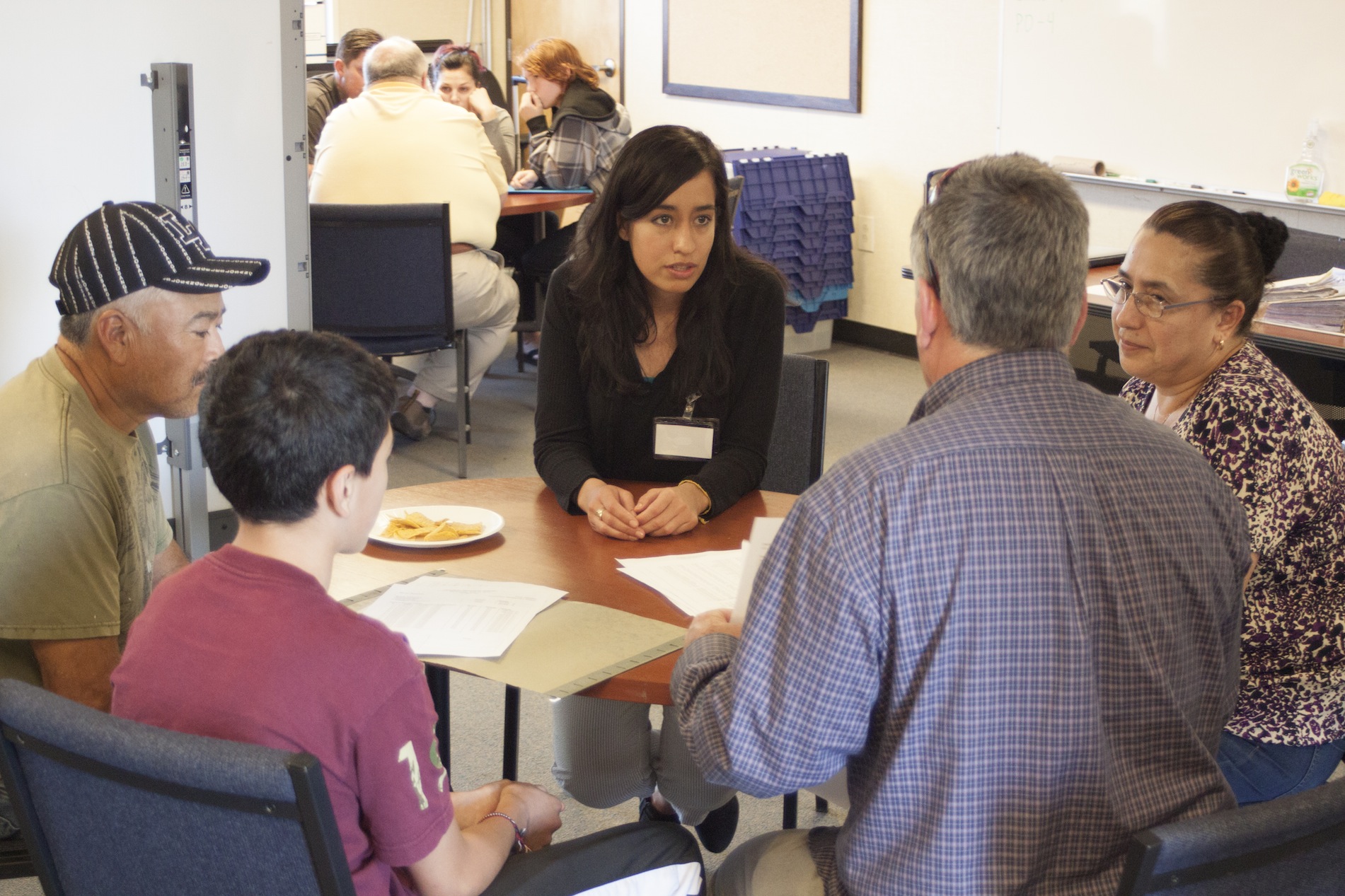
Stanford GSE program provides school interpreting in rural district
Para leer la versión de esta historia en español, por favor pulse aquí.
María Guzmán nodded that she understood when her son's social studies teacher asked about GPA and test scores during the spring parent-teacher conference at Pescadero Middle School. But her face wasn't convincing: a nervous smile, eyes glancing down and away, cheeks slightly flushed.
Picking up the cues, Efraín Brito, a PhD student at Stanford Graduate School of Education who was seated just to Guzmán's right, asked her again, this time in her native Spanish, adding in the same breath a reassuring explanation about where her son stood compared to other students in the district.
"Ah," Guzmán smiled, looking relieved now that she knew her son was actually a high performer in reading. "I understood about 70 percent but I didn't really follow how he compared. Now, it's clear," she told Brito in Spanish.
Brito, a school/community interpreter, was at the table thanks to the Stanford-Pescadero School Community Interpretation Project, a research and practice initiative started by GSE Professor Guadalupe Valdés in response to a request from Suzanne Abel, then Academic Director of the nonprofit Puente de la Costa Sur, and school Principal Pat Talbot of the La Honda-Pescadero Unified School District.
 GSE student Efrain Brito, second from left, interprets with Maria Guzman, her son and his teacher, Randy Vail at Pescadero Middle School.
GSE student Efrain Brito, second from left, interprets with Maria Guzman, her son and his teacher, Randy Vail at Pescadero Middle School.
The project recruits 12-15 Stanford students to interpret twice a year at parent-teacher conferences at the middle and high schools in Pescadero, a coastal town 30 miles from the university where the majority of public school students are children of very low-income farm and nursery workers and other low paying service jobs.
The initiative, started in April 2013, is part of a wider inquiry by Valdés into the underdeveloped field of interpreting in educational settings. Valdés, who is a leading researcher in bilingualism and a founding partner of the Understanding Language initiative at the GSE, says that ensuring language access for people with limited English resources in schools by using interpreters isn't as well established as it is in medicine or law, where there are handbooks on best practices and required certification processes.
"There are currently no established standards for brokering communication in educational settings for interpreters, that is, for individuals who work with the spoken language“ said Valdés, who herself is a certified court interpreter.
A matter of equity
Typically schools do employ translators (individuals who work with the written language) to provide written versions of important school documents and forms. They also provide interpreters (persons who work with the spoken language) for larger gatherings and meetings, including PTA meetings, Valdés said.
But they often miss the more intimate parent-teacher conference, where families have the opportunity to connect with teachers and chart a path for success for their kids.
"In school settings, what is needed are individuals trained in school/community interpreting, a practice which includes mediating and brokering communication," Valdés said. "Providing language access in such settings involves helping individuals understand the context in which the message is bring communicated, the ways that American classrooms work, and the expectations that both teachers and parents bring to interactions with parents."
Valdés noted that in addition to not knowing English, the parents in communities where interpretation is necessary may also not understand the school system itself.
"So interpreters need to have this kind of cultural awareness too. They are not advocates for either side, but they can act as cultural mediators," Valdés said. "They can help both sides come to a better understanding."
Valdés, through her own research, has narrowed in on what makes for a good interpreter in educational and community settings and is working on putting together guidelines. She also teaches classes at Stanford on interpreting and trains the students and staff who volunteer in Pescadero.
"It's very much a matter of equity," said Abel, now Academic Director emerita of Puente de la Costa Sur, who worked side-by-side with Valdés to develop the initiative.
 GSE student Maddie Orenstein, right, interprets during a parent-teacher conference at Pescadero Middle School.
GSE student Maddie Orenstein, right, interprets during a parent-teacher conference at Pescadero Middle School.
Puente first partnered with Valdés to develop a comprehension-based English Language program for the region. It was through that effort that parents shared their desire to understand more about their children’s progress in school.
"If a parent cannot connect with his or her child's teacher, he or she is missing a core element of their child's school experience," Abel said.
Se habla Español
The route from Stanford to Pescadero is the winding, two-lane Highway 84, which cuts through the mountains that divide Silicon Valley from the San Mateo coast.
Along the way you pass through thick forest, yet when approaching Highway 1, which hugs the Pacific, the land opens up to rolling farms: lettuce, artichokes and berries crowd the landscape.
Downtown Pescadero is about 2 miles inland from the water and on weekends is a haven for cyclists and other tourists. The town, population about 650, is known for its fresh berry pies, award-winning goat cheese and artisanal artichoke bread.
Farther back into the farmland, past weathered single story homes, sit the middle and high schools. They are adjacent to each other, sharing the same campus.
When the Stanford students arrive to interpret for last spring's parent-teacher conferences, they are prepared to split their time between the upper and middle grades.
In the high school, tables are set up in the auditorium, with dividers adding privacy. The middle school parents and teachers meet in the district office portable about 30 yards away, also furnished with tables and dividers. There are dozens of chairs in each set up for brothers, sisters and other family members who often come to the meetings.
When a family is called for the conference, the parents are asked whether they'd like an interpreter. If yes, they all sit at a table together and teachers join for a conversation, one subject at a time. Math, science, social studies, English.
"It was a game-changer to have interpreters," said Randy Vail, who teaches social studies at the middle school. "Now you know the parents are getting the true story about what's going on at school."
Before there were interpreters, the students themselves stood in the role.
"That is lousy in a bunch of ways," said Elaine Bahr, who teaches middle school science and math.
Bahr said having the kids translate took the power from the parents and sometimes led to distrust between the students and teacher, who wasn't sure if what he or she was saying was actually being explained.
"Having an interpreter provides for better transparency and a better relationship all around," Bahr said. "It's not just helpful. It's necessary."
Talbot, the principal, said in those earlier days, the student-led conferences were designed to empower students regarding their academics and a few floating interpreters were available for clarification. The difference with Stanford interpreters is that there are enough of them to focus on the language and tone and help an individual family throughout the conference process.
That the Stanford students are most often graduate students in the GSE means they also bring a unique level of understanding to the task.
"I've had them explain data because I know they can handle it," said Kevin Allen, who teaches English. "You wouldn't be able to do that if they didn't have that background."
The Stanford participants who are accepted into the program must be native- or near native-Spanish speakers with interests in educational equity, getting involved in a community partnership and contributing to research and scholarship on interpreting and parent engagement in schools. While most are graduate students, some are undergraduates and Stanford staff.
"It was important to me that the education school was engaged in the community," said Mariana Barragán, who received a master's degree in August from the GSE in the International Comparative Education program and interpreted last spring. "It was amazing to see how empowering the interpreting was for parents. They really care about their child's education and the interpreting helps close a gap that stands between them and their child."
 GSE student Jessica Barajas, center, interprets during a parent-teacher conference at Pescadero Middle School.
GSE student Jessica Barajas, center, interprets during a parent-teacher conference at Pescadero Middle School.
Eduardo Muñoz-Muñoz, who is a PhD candidate at the GSE, was in charge of recruiting and supporting interpreters for the last two years. He said the program is mutually beneficial for the community and Stanford.
"The GSE grows from every opportunity to have partnerships with practitioners and field educators," he said. Partnerships, he added, "remind us of how schools function, their potential and their challenges."
And he said the initiative has an immediate impact in the families of the students of Pescadero.
"Before these interpretations, extremely valuable feedback about the future of the students, situations of risk or potential alliances between parents and teachers simply did not happen," he said. "We ourselves have often commented on vital pieces of information that would not have been communicated had we not been there and, most importantly, had not the teachers and the parents welcomed us into their communities."
Total understanding
Guzmán's conference took place for at least an hour. Brito, the teachers and Guzmán went through charts, grade reports and how to track homework through the computerized system.
"Do you understand this report?" Brito asked Guzmán during one exchange, pointing at the paper on the table. "It shows progress in math."
Guzmán said the interpretation is a blessing. "In the past we managed between my little English and the teachers' little Spanish," she said. But it was a struggle — and it was awkward and not very fulfilling.
Now, Guzmán said, she not only understands what's happening with her son at school but she also feels like she has a better rapport with the teachers.
"It's not complicated," she said, when asked to explain how the exchanges are different with interpretation. "We simply can now understand each other 100 percent."
__
Photo credit: Marc Franklin/Stanford Graduate School of Education



